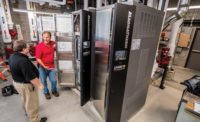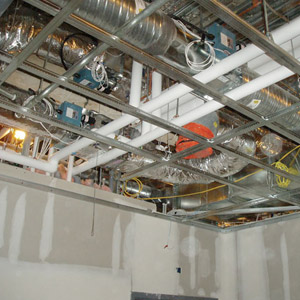
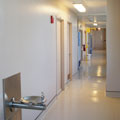
Hudspath, the lab project manager at the Center for Medical Science in Albany, N.Y., had to take an 8,000-square-foot space allotment on the third floor of a fully occupied five-story building and transform it into a BSL-3 lab where select agent research work could be safely accomplished. Select agents and toxins are regulated by the Centers for Disease Control for the U.S. Department of Health and Human Services. These agents could be used in future terrorist attacks.
Hudspath had a mere four months to get the project done without disrupting existing tenants. The project quickly came to fruition when a scientist won federal grant money to expand CMS’s BSL-3 bio-safety facilities to prepare for upcoming projects.
In BSL-3 labs, researchers conduct experiments on contagious materials in gas-tight enclosures. A bio-safety level designates the bio-contaminant pre-cautions required to isolate hazardous biological agents in an enclosed facility. BSL-3 labs study airborne agents with potential to cause lethal infec-tion.
BSL labs are ranked from 1 to 4 with 4 being the highest. CMS is one of the elite BSL-3 labs in the country.
“They are handling some delicate things in there. The containment of those spaces is critical,” notes SAGE Engineering Associates PrincipalJohn Edwards, P.E. Sage provided engineering design services on the project.
Identifying Concerns
In addition to dealing with a small space, the lab project had to take into account a number of other vital variables. For starters, research had to be validated within the precise space where scientists do the work.The building also had to stay operational with no interruption to tenant occupancy. The floor immediately below the lab space contains densely popu-lated administrative areas, while the floor above has BSL-2 lab facilities, offices and equipment alcoves. Those areas have different tenants thus no space was available to relocate staff.
The construction work had to be completed before the Centers for Disease Control could begin its two-month-long validation process for BSL-3 li-censing.<
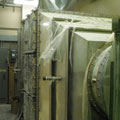
Looking For The Right Solution
With a space constantly dealing with extremely delicate materials, Hudspath, who was confident HVAC and electrical installations would not pose a problem, identified wastewater containment and treatment as the project’s chief concerns.Total control of wastewater is essential to safety. Scientists cannot be exposed to harmful agents and no micro-organisms can be allowed to escape into the environment. Any breach could have catastrophic health implications.
“You immediately have issues with containment concerns above and below and all the way around the space,” Hudspath says. “You have to control the flow of wastewater.”
Hudspath met with Edwards - the two had worked together on previous projects - about the waste-containment issue. Edwards, whose group had worked on a standalone BSL-3 lab studying the West Nile virus in the early 2000s, mentioned to Hudspath the concept of vacuum plumb-ing.
“We’ve designed vacuum sanitary before in grocery stores and we studied the use of it in correctional projects, so we were familiar with it,” Edwards states. “We talked about it on and off and Jim was intrigued by the idea.”
That led the group to Chino, Calif.-based AcornVac and its vacuum plumbing system. Edwards and Hudspath were shown the AcornVac system at the manufacturers rep office in Connecticut.
The system transports wastewater from fixtures through an engineered, overhead drainage-piping network (there is no need for floor excavations) before discharging to sanitary waste mains. The system’s Vac Central unit features waste collection tanks, vacuum pumps and controls that automate the entire operation. The control programming runs the vacuum pumps only as needed to maintain vacuum pressure in the sealed waste-collection tanks and in the drainage-piping network, which routes through the facility to the waste-collection tanks.
Vacuum interface valves separate plumbing fixtures and equipment from the vacuum piping network. Wastewater transports vertically to the over-head piping network via the interface of atmospheric and vacuum pressures. This flow occurs when the normally closed interface valves, which sepa-rate the fixture from the drainage-piping network, open.
“By using the vacuum system, we’re able to collect all wastewater in the space allotted for,” Hudspath says. “There is no piping above or below the space. Everything is contained inside the space. The big concern was any spill that could get out of the space. If you have to drill through all of the floors and there is wastepipe and you have a leak, you are contaminating the space below.”
AcornVac has been providing vacuum plumbing solutions in myriad commercial settings for 20 years.
“The BSL-3 lab probably has the most unique waste-stream characteristics,” AcornVac Vice PresidentLaura Marshallstates. “Vacuum plumb-ing provides a unique solution for this lab that needed to minimize the risks to other occupants by completely containing the waste. It’s a dual benefit. It’s always a construction solution and in this case the additional benefit is the containment.”
Bring Your Friend Along
The lab’s sanitary system features two separate components married together to form a well-oiled waste-removal machine. In addition to the vacuum plumbing system, a decontamination system by Practical Applications is also part of the overall setup. The two vacuum system waste-collection tanks (60 gallons each) discharge into the two decontamination tanks (350 gallons each), operating in a lead-lag fashion and delivering a continuous flow of wastewater. The de-con system treats the wastewater before sending it into the city system.The two systems are stacked on top of each other (the de-con system is on the bottom) in the lab’s mechanical room. The vacuum system tanks collect wastewater 8 feet above the floor.
“There had to be a lot of coordination with the vacuum system and the de-con system. It needed 100% redundancy,” Edwards notes. “When the holding unit is full, it opens up, discharges and flows down into the de-con unit. There is nothing that says the de-con unit and the holding unit get full at the same time. They are not the same sizes. We had to carefully coordinate enough capacity on either side. In case there was a failure, there would be enough capacity on the reverse side to get rid of it.”
SAGE Engineering Group Mechanical ManagerDave Laytonadds: “Coordinating the sizing of the system was a challenge. With the two tanks, there is always a tank ready when needed. We also had to make sure there was enough capacity to work in all circumstances.“
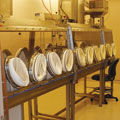
Airing It Out
The lab’s ventilation system requires special attention. A 15,000-CFM, bag-in, bag-out, HEPA-filtered central exhaust system with constant volume air-flow boxes maintains constant space negativity toward areas of higher contamination.“In a BSL-3 lab and any type of system like this, it does potentially bleed air out,” Layton says. “HEPA-filter plumbing vents are not a normal thing. If there is a purge out of one of the valves, that little puff of air has to be taken care of.”
Tek-Air constant volume boxes connected to a new supply distribution duct provide supply air. The air in the space changes over 12 to 15 times an hour. “If there is ever a spill, the continuous air change will get the bugs out in the exhaust,” Hudspath says. “The HEPA-filters filter 100% of the ex-haust.”
The exhaust is handled through an uninterruptable power source capable of keeping the fans operating up to 90 seconds while the generator is starting and picking up the building load. It is essential the space remains negative at all times under all circumstances.
Air balancing is one of the trickier components in the space.
“You have 8,000 square feet and every room has an airlock,” Hudspath explains. “You are trying to keep the right pressurization across every single door in the space. You are tightening up the doors to get the differential pressure. It makes things more complicated, but we were able to do it.”
Pressure indicators are located above each door so occupants can continuously monitor room pressures. These pressure indicators tie into the building management system for monitoring and alarming.

Constant Traffic
The system in the BSL-3 lab treats 28,000 gallons of water per day. That’s not surprising given the fact there are 19 plumbing fixtures (a combina-tion of AcornVac showers, lav sinks and hand sinks). The vacuum system services four showers, four lav sinks and 11 hand sinks. Lab workers cannot leave the lab without a decontamination shower.“They have to shower each time they exit the lab and go through an airlock locker room,” Hudspath states. “The showers are stainless-steel pass-through showers. You go in through a curtain on one side, through a stainless-steel metal door on the other side and step out into your civilian clothes.”
Controlling the stress put on the system in times of high use is a major priority.
“If you have four people taking a shower at the same time, that’s a significant load,” Hudspath says. “We had to make sure the vacuum was continu-ing to work and taking away all of that wastewater. We started out with six people there and could have as many as 18 people in the space. Think about how many people are going in and out of there and showering. We based most of the sizing of the tank on the effluent coming from the de-con showers and the maximum flow rate on the showers.”
Edwards adds: “The system is sitting there and everything is still and then, bam, a big slug of water is pulled into the pipe. Movement thrusts cause failures. It’s similar to addressing water-hammer issues in water-supply piping, only more critical. Because the system is under vacuum, any leaks will leak air into the pipe instead of leaking contaminants out of the piping. It’s a great advantage.”
Another key part of the system’s installation success was the use of Charlotte Pipe CPVC ChemDrain piping, which was specifically listed in labora-tory waste settings.
“One of the concerns was a slug of liquid shocking the system,” Layton states. “We wanted to use sweeping elbows to minimize it. The cost and the simplicity of installation were big factors and the fittings tied in nicely with the vacuum system. It was very compatible.”
The collection of wastewater via vacuum provides several benefits. The vacuum center can be placed outside containment and when the inlet piping is HEPA-filtered it remains clean and provides for easier maintenance. If the vacuum piping accidentally breaches, nothing leaks out and containment re-mains intact. The vacuum cannot be over-pressured.
After an extensive certification process upon completion by the Centers for Disease Control, the BSL-3 lab is operating smoothly and safely.
“We were able to take 8,000 square feet and gut it out, rebuild and accommodate a higher level of containment than would normally be in this building,” Hudspath says. “We were able to do it in a safe method because of the vacuum plumbing system.”


